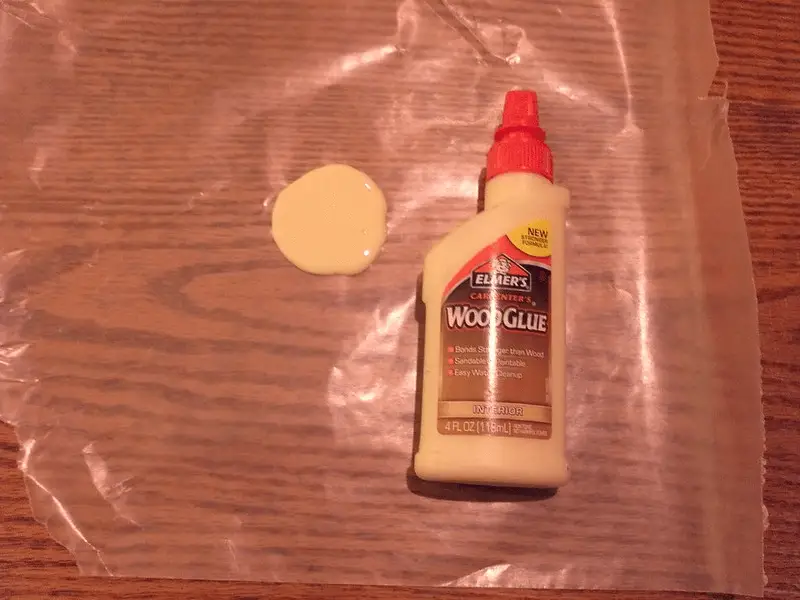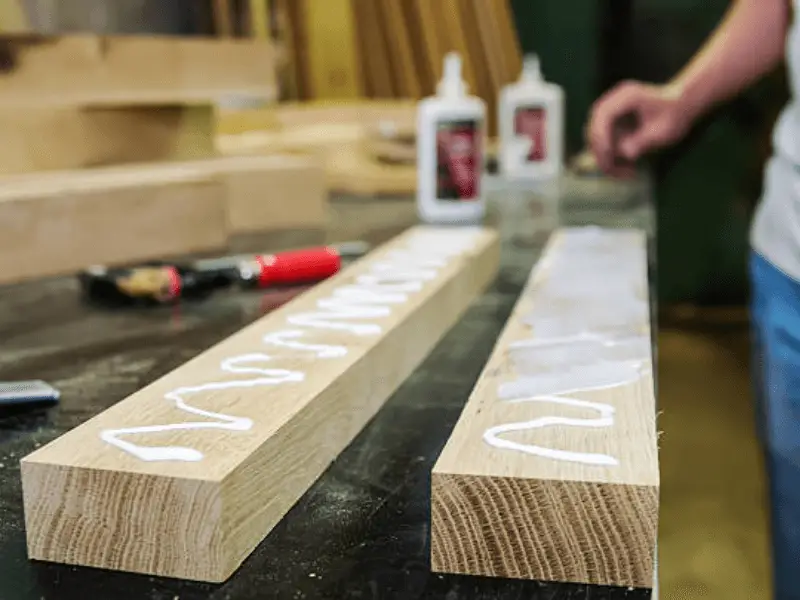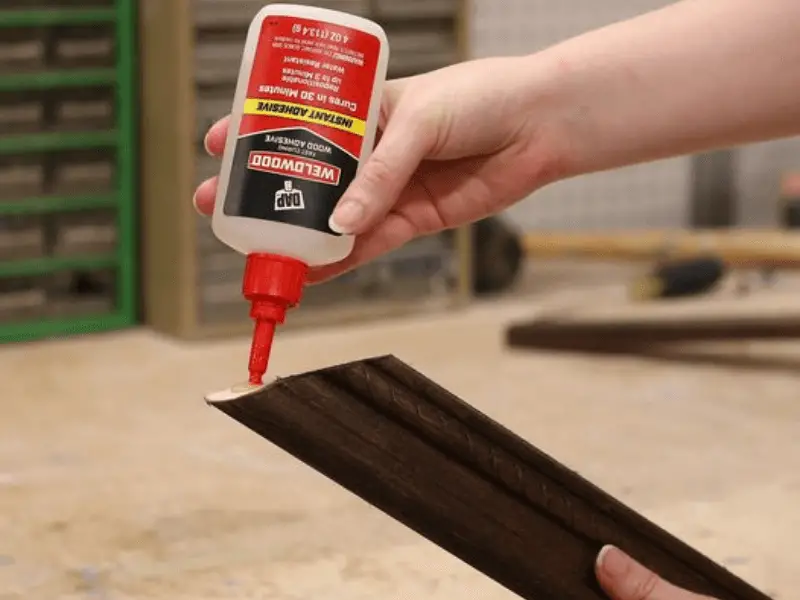Wood glue is designed to create a strong bond between porous, raw wood surfaces. So, naturally, you might wonder if it can also work its magic on painted surfaces. Things get tricky here, and understanding the dynamics between wood glue and painted wood becomes crucial.
In this comprehensive guide, we’ll delve into the heart of this matter. We’ll discuss how wood glue interacts with painted wood, the challenges you may face, and how you can achieve a strong bond despite these hurdles.
The Relationship Between Wood Glue and Painted Wood
Firstly, it’s crucial to understand how wood glue works. Wood glue creates a bond by soaking into the porous surface of the wood and then hardening. This process is what gives the glue its holding power. Nevertheless, you can apply wood glue to painted wooden surfaces, but you won’t get the best results from the glue. Painted wood presents a challenge because the paint creates a non-porous, sealed surface. This seal prevents the glue from soaking in as it should, thus reducing its effectiveness.
So, if your woodworking project involves painted wood, what can you do? Here are a few solutions:
- Sand the Painted Surface: Sanding the painted surface until you can see bare wood allows the glue to seep, creating a stronger bond. Be sure to clean off any dust before applying the glue.
- Use a Different Adhesive: Certain adhesives are designed to work on painted surfaces. Some of these include epoxy resin, polyurethane glue, and construction adhesives. Each adhesive has pros and cons, so consider your project’s specifications and requirements before choosing.
Remember, the key to a strong bond between wood glue and painted wood is to ensure the adhesive can penetrate the wood’s surface. While painted wood may pose some challenges, it’s a manageable hurdle. With some patience and the proper knowledge, you can achieve a strong bond—even with painted wood.
Choosing the Right Wood Glue for Painted Wood
As we have seen, though it is difficult for glue and painted surfaces to adhere well, we can still do it. Therefore, it is essential that you first consider a few additional factors when it comes to painted wood. Here are some tips to help you make the right choice:
Consider the project:
- Are you working on an indoor project or something that will be exposed to the elements? For outdoor projects, you’ll want to choose a water-resistant glue, like epoxy resin.
Check the paint compatibility:
- Not all paints are created equal. Some forms, like enamel or oil-based paints, make a hard, non-porous finish that can prove challenging for wood glue to adhere to. On the other hand, latex-based paint, being relatively soft and porous, may allow a better bond. However, bare wood is always the best option for the strongest bond.
Always check the manufacturer’s guidelines to ensure the adhesive you choose is compatible with the paint on your wood.
Quality of the Wood Glue
- Of course, the quality of the wood glue itself matters. A high-quality adhesive designed for bonding painted surfaces can make a difference. Numerous types of wood glue are available, and each has strengths and weaknesses when bonding to painted surfaces.
Always follow the manufacturer’s instructions for the best results.
Test the bond
- Before gluing pieces together, test the glue on a small, hidden area to ensure it bonds well.
Surface Preparation
- Adequately preparing the surface is critical. Even the best wood glue may only bond if the painted surface is adequately prepared. Ensure the surface is clean, dry, and lightly sanded for optimal bonding conditions. Remember, a roughened surface will provide more grip for the glue, increasing the success of the bond.
The Environment
- Environmental conditions like temperature and humidity can also affect the bond. Wood glue typically requires a certain degree of moisture to cure correctly. If the environment is too dry or humid, it can negatively impact the bonding process. Likewise, extreme temperatures can also affect the glue’s effectiveness.
In conclusion, while it is possible to use wood glue on painted wood, several factors can impact the bond’s strength. Therefore, understanding these factors and how to manipulate them to your advantage will help ensure a successful bond.
Type of wood glue and the Right one on Painted Wood
Choosing glue becomes a crucial step when it comes to painted wood projects. Different paints on your surface react differently to wood glue’s bonding agents.
PVA Glue

Polyvinyl Acetate, or PVA, is a versatile type of wood glue that works well for most projects. It’s easy to use, dries clear, and creates a strong bond. It bonds better to water-based paints such as latex and acrylic-painted surfaces because it allows for some penetration and bonding. However, it’s not the best choice for outdoor projects as it’s not exceptionally water-resistant.
Epoxy Resin
This is a robust two-part adhesive, making it an excellent choice for projects that need a serious hold. Epoxy resin is also water-resistant, which is a plus if you’re working on an outdoor project. It works better on oil-based, painted wood. However, it’s more challenging as it requires careful mixing and has a longer curing time.
Hide Glue
Made from animal collagen, hide glue is a traditional adhesive used for centuries. You can apply the hide glue to porous wood areas for maximum bonding strength. Nevertheless, when applying hide glue to painted wooden surfaces, this glue wood has better adhesion to water-based paints than oil-based paints because oil-based paints are known to seal the wood’s pores, limiting the soaking of glue into the wood.
Cyanoacrylate (CA) Glue
Also known as super glue, CA glue dries quickly and creates a strong bond. It’s great for small, quick projects but could be better for more extensive projects due to its short open time. It works better on water-based paint when it comes to painted wood surfaces.
Steps to Take Before Applying Wood Glue on Painted Wood: Preparation

Before you embark on your woodworking project, there are several key steps you need to take to prepare your painted wood for glue application. This preparation is crucial to ensuring a secure bond and a durable, visually pleasing result.
Step 1: Cleaning the Surface
Begin by thoroughly cleaning the painted wood surface. Dirt, grease, or residual substances can interfere with the bonding process. Use a soft cloth and mild detergent to gently cleanse the surface, then let it dry completely.
Step 2: Sanding the Surface
After the surface is dry, lightly sand it. This process, known as scuffing, creates minute scratches on the painted surface, providing the glue with more surface area to bond to. Use fine-grit sandpaper for this task, and remember, the goal here is not to remove the paint but to create a slightly rough texture. After sanding, wipe away the dust with a dry cloth.
Step 3: Testing the Glue
Before applying the wood glue, testing it on a small, inconspicuous area of the painted wood is imperative. Allow it to dry, and check the strength of the bond. Suppose the bond is weak or the glue peels off. In that case, there’s a chance your paint is not compatible with the wood glue. You may need to consider another adhesive or even sand the paint off completely.
Step 4: Applying the Glue
Once you’ve ensured the glue will effectively bond, it’s time to apply it. Spread a thin, even layer of wood glue on the painted surface, then join the pieces together. Remember to apply pressure for the recommended time to allow the adhesive to bond correctly with the wood.
Step 5: Curing the Glue
After the glue has been applied, it’s necessary to let it cure properly. The curing time varies depending on the type of glue used and the environmental conditions, so always follow the manufacturer’s instructions. A fully cured bond will ensure optimal strength and durability.
Conclusion
In conclusion, achieving a solid bond with wood glue on painted wood is not impossible. It all depends on the proper knowledge, preparation, and selection of appropriate materials. While wood glue can work on painted surfaces, it’s clear that the bond’s strength and durability greatly depend on several factors.
The type of paint used on the wood, the way the surface is prepared, the quality of the wood glue, and the environment in which the bonding process takes place all play a significant role.

